|
Author
|
Topic: Air and Space Museum: Restoring LM-2
|
AFGAS
Member Posts: 89
From: Merritt Island, FL
Registered: Feb 2008
|
 posted 06-25-2009 03:30 PM
posted 06-25-2009 03:30 PM
   
While visiting the National Air and Space Museum on Tuesday, June 23, 2009, I found that Lunar Module-2 (LM-2) was undergoing a recovering of the decent stage with new kapton. LM-2 was built to fly a low Earth orbit test flight to prove the techniques of separation, rendezvous, and docking with the Apollo command and service module. The second of two such test vehicles, its mission was canceled because of the complete success of the first flight, Apollo 5. 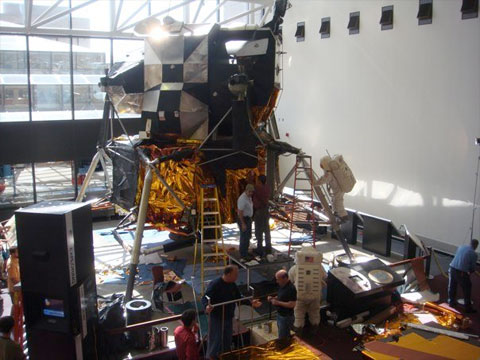 In the photo above curator Allan Needell is standing next to the Apollo figure in front of LM-2. He reported the job was going well -- the first time this has been done since acquisition -- and offered a few surprises, like the image below. Most Apollo fans know that the Apollo 12 moonwalkers erected an umbrella shaped S-band antenna to communicate with Earth, but there was also one on Apollo 11 as a back-up (of course, it was never used/needed and remains on Eagle's decent stage on the Moon). What was not known was an antenna was also placed on LM-2. 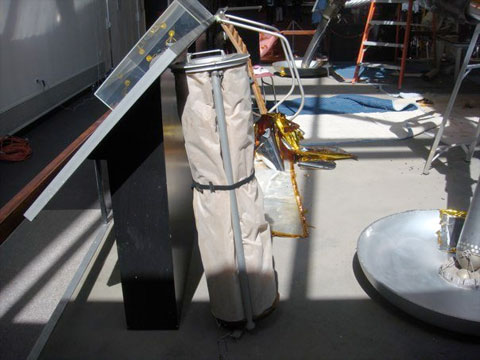 The above image is the stowage container for the antenna, which is inside. I'll have more images and information posted on the Field Guide, as well as updates from Allan. Jim Gerard
A Field Guide to American Spacecraft |
Robert Pearlman
Editor Posts: 42988
From: Houston, TX
Registered: Nov 1999
|
 posted 06-25-2009 03:44 PM
posted 06-25-2009 03:44 PM
   
Smithsonian.com: Apollo Lunar Module Gets a Facelift Some repairs have been done to the LM-2 over the years, but this project, said [Allan] Needell, is the "biggest and by far, the most conscientious.""It's the Smithsonian's responsibility to preserve the authenticity of the original object as much as possible," he added. Fjeld, a space artist who led a similar project on the LM-13 at the Cradle of Aviation Museum in Long Island, and built all the historically-accurate models used in Tom Hanks' HBO series "From the Earth to the Moon," was brought in to do the job. The conservation team is using only the original kinds of tape, foil and techniques. "It's an exquisite piece of hardware of a sort we don't see much," said Needell. "People have seen the photograph of Neil Armstrong stepping off the ladder, but seeing the equipment creates some context." The LM-2 will soon look much like the Apollo 11 Eagle (LM-5) that set down at Tranquility Base in 1969 and made history. 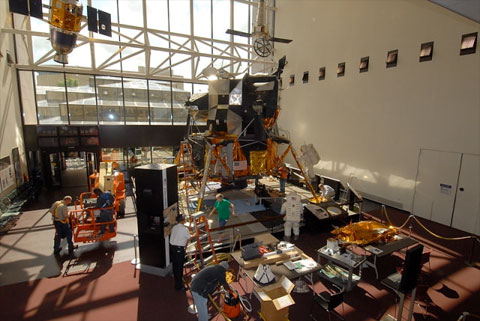 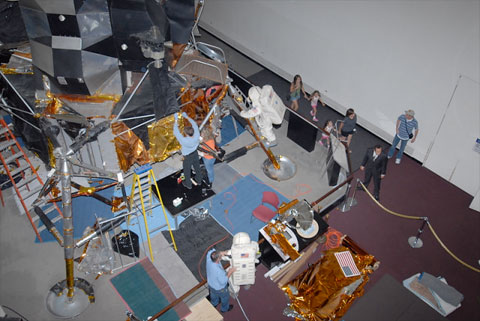
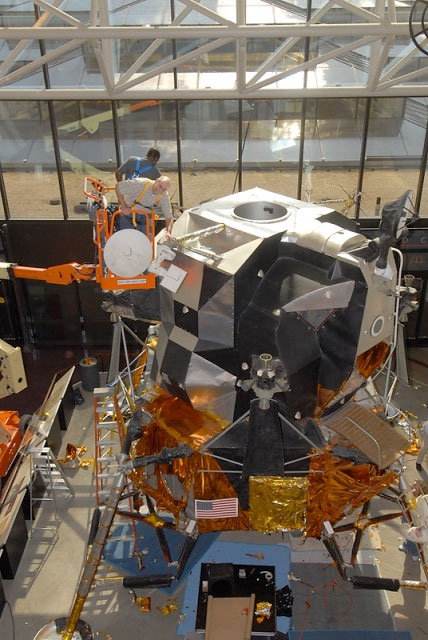
Photo credit: Matt Breitbart/NASM
|
Robert Pearlman
Editor Posts: 42988
From: Houston, TX
Registered: Nov 1999
|
 posted 06-25-2009 03:51 PM
posted 06-25-2009 03:51 PM
   
AirSpace: The Donor Making The Difference: The Eagle Is Being Restored In offering his support, Gar recognizes the LM-2 as "an important icon, not only representing one of America's greatest engineering and scientific achievements; it remains a tribute to the extraordinary efforts of over 400,000 engineers, technicians and scientists who made the promise of Project Apollo possible."Now, on the eve of the 40th Anniversary of the Apollo 11 lunar landing, Gar and his wife Kathryn are proud to help refurbish the LM-2, so that all Museum visitors can experience this "giant leap for mankind" as if it were July 20th, 1969.
|
collocation
Member Posts: 383
From: McLean, VA, USA
Registered: Feb 2004
|
 posted 06-25-2009 03:53 PM
posted 06-25-2009 03:53 PM
   
There is also a picture of the restoration with the folks involved in today's (June 25) Washington Post. |
Aztecdoug
Member Posts: 1405
From: Huntington Beach
Registered: Feb 2000
|
 posted 06-25-2009 04:54 PM
posted 06-25-2009 04:54 PM
   
I am curious about the construction of the LM. Say you got a wild hair, and permission, could you climb up the ladder open the hatch and climb in for a look? Or would your Earthly weight crush the ladder, the porch and the floor of the Ascent stage as it was built for 1/6 Earth gravity? |
ilbasso
Member Posts: 1522
From: Greensboro, NC USA
Registered: Feb 2006
|
 posted 06-25-2009 06:47 PM
posted 06-25-2009 06:47 PM
   
I think it depends on your Earthly weight! In my case, the LM might sink into the parking garage.I have a piece of the original Kapton foil from LM-2, which was obtained when I was a high school tour guide at the Air and Space Museum (when it was still at the Arts and Industries Building) and the LM was initially being readied for display. One of the curators cut some pieces off a spare piece of the descent stage foil and gave them to the tour guides. 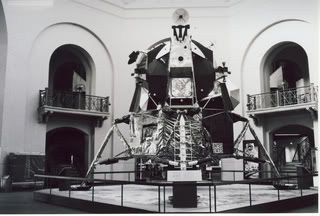 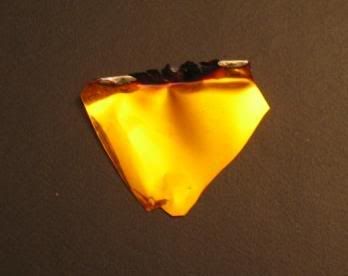 |
Robert Pearlman
Editor Posts: 42988
From: Houston, TX
Registered: Nov 1999
|
 posted 06-25-2009 07:31 PM
posted 06-25-2009 07:31 PM
   
Eric Long photographed the interior cabin of the ascent stage for the Smithsonian in 1999, so at the very least, he was able to support himself inside the hatch. I am also fairly positive that a popular space historian and author had a chance to climb up and in LM-2 years ago, but I want to confirm that with him before saying more. |
dsenechal
Member Posts: 539
From:
Registered: Dec 2002
|
 posted 06-25-2009 09:34 PM
posted 06-25-2009 09:34 PM
   
quote:
Originally posted by Aztecdoug:
I am curious about the construction of the LM.
I had the privilege of spending an hour or so on, in, and under LM-9 before it was relocated and suspended in its present location at KSC. This including climbing the ladder, going through the hatch and inside the ascent stage, looking outside through the windows, etc. It supported my weight with no difficulty - it seemed surprisingly sturdy, in fact. |
damaker
New Member Posts:
From:
Registered:
|
 posted 06-26-2009 06:42 AM
posted 06-26-2009 06:42 AM
   
The LMs in DC and KSC are the only two authentic flight ready ones that remain correct? Where did the others like the one in Chicago come from? |
Apollo Redux
Member Posts: 346
From: Montreal, Quebec, Canada
Registered: Sep 2006
|
 posted 06-26-2009 08:00 AM
posted 06-26-2009 08:00 AM
   
quote:
Originally posted by ilbasso:
I have a piece of the original Kapton foil from LM-2...
Very cool.  |
KSCartist
Member Posts: 2896
From: Titusville, FL USA
Registered: Feb 2005
|
 posted 06-26-2009 08:11 AM
posted 06-26-2009 08:11 AM
   
Does anyone know the type of metal alloy and the thickness that made up the "skin" either interior or exterior of the LM. I've always remembered hearing that you could punch a hole through it with a screwdriver if you weren't careful. |
SpaceAholic
Member Posts: 4437
From: Sierra Vista, Arizona
Registered: Nov 1999
|
 posted 06-26-2009 08:24 AM
posted 06-26-2009 08:24 AM
   
The cabin of the ascent stage was a semimonocoque structure with two different alloys 2219 and 7075-T6 employed for the longerons and sheet metal. |
Lou Chinal
Member Posts: 1306
From: Staten Island, NY
Registered: Jun 2007
|
 posted 06-26-2009 01:05 PM
posted 06-26-2009 01:05 PM
   
Josh Stoff of the Cradle of Avation Museum allowed me access to the LM that would have flown on Apollo 18. The internal structure was rather spartan. I was told that I was climbing an orignal ladder, the one that would have been used on the moon. I did not feel it or the floor was about to buckle under my weight. Of course this was 20+ years ago and I was a lot lighter than. |
space1
Member Posts: 853
From: Danville, Ohio
Registered: Dec 2002
|
 posted 06-26-2009 06:28 PM
posted 06-26-2009 06:28 PM
   
A quick look at my reference data shows that the pressurized cabin web thickness was specified as thin as "0.015 to 0.025" inches thick. About every 3-4 inches the thickness increased to "0.055 to 0.065" inches, centered on ribs of 0.812 inches depth, 0.04 inches wide. |
Robert Pearlman
Editor Posts: 42988
From: Houston, TX
Registered: Nov 1999
|
 posted 06-27-2009 04:55 PM
posted 06-27-2009 04:55 PM
   
Paul Fjeld, who as mentioned was brought in by the National Air and Space Museum to oversee the restoration of LM-2, is also a collectSPACE member and though his current schedule doesn't allow him to monitor this forum, he has graciously agreed to reply to questions about the project as well as share some photos. To get things started, I posed to him a few initial queries: What is the scope of the project?Briefly, the LM-2 job is in two phases - make it look okay for the 40th [anniversary], then do a proper and complete restoration. I am preparing a report and plan for the big restoration where I will argue to create a "hybrid" example of LM-2 and LM-5 where EVERYTHING of the external vehicle is flight quality, both in substance and application. Allan Needell, the Curator responsible for the LMs, is very committed to having the few remaining examples of the Lunar Module properly restored with the techniques recorded to make it easy for following generations to maintain their quality. What became of all the kapton you removed from the LM? The Kapton and blanketing that was on LM-2 was not all thrown away. Very little of it was proper - a lot was applied quite quickly as a PR effort to simulate Apollo 11 as I believe Grumman had very little time back in April '71 to rework it for the Smithsonian. Maybe 90% of LM-2's original cover wasn't there in the first place. They bagged the Descent Stage with a giant sheet of polyethylene, then hung some sheets of 2 mil Aluminized Kapton which crumbled after 33 years in the sun! Some samples of that are being analyzed, and the rest is trash unfortunately. It just broke apart and was covered in dust and filth! It must have been quite an honor to be able to work on such a prevalent artifact... and what a fun challenge, too! It was indeed a dream challenge for me. It was incredibly hard work - I was overly optimistic about how long it would take, but we got done more than we hoped in the extremely limited time that we had thanks to everybody's enthusiasm. That was a GREAT and fun crew, some of whom can be seen in the picture I'm attaching. Two of the conservation interns are going to redo the deployment trusses in the next couple of weeks and then Phase 1 will be done. It is already a much more accurate representation of a lunar lander and it is clean(ish). I hope it withstands the scrutiny of all the Apollo fans out there!
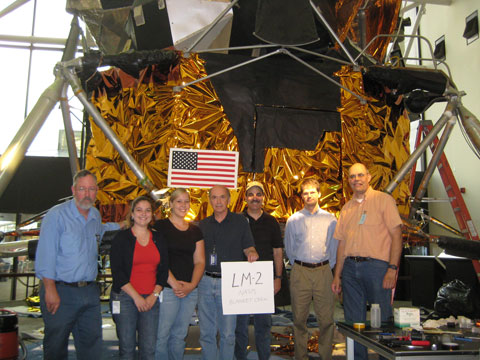 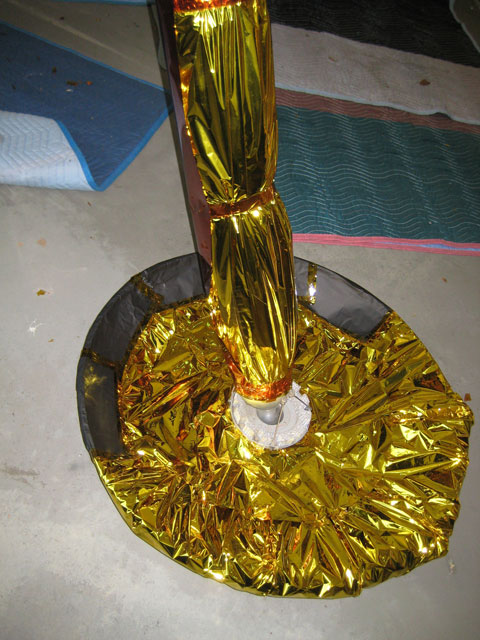
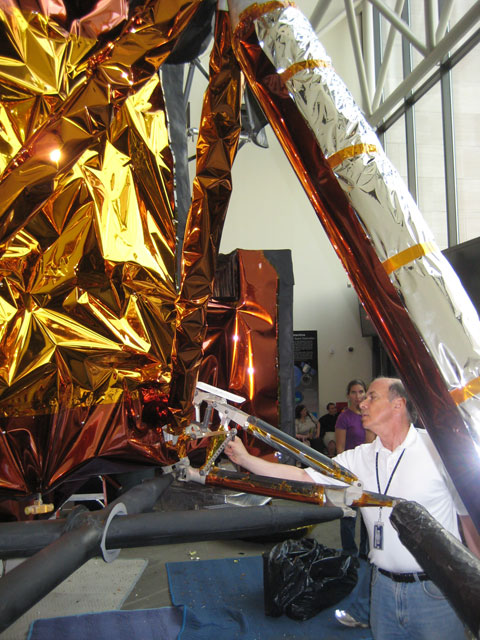
Photo credit: Paul Fjeld
If you have questions about the project for Paul, please post them to this thread. I will forward them to him for his response as his schedule will allow. |
ilbasso
Member Posts: 1522
From: Greensboro, NC USA
Registered: Feb 2006
|
 posted 06-27-2009 05:56 PM
posted 06-27-2009 05:56 PM
   
...then hung some sheets of 2 mil Aluminized Kapton which crumbled after 33 years in the sun! What does this bode for the Kapton that has been sitting in lunar surface conditions for 40 years? |
MichaelD
Member Posts: 90
From: Troy Michigan USA
Registered: May 2009
|
 posted 06-30-2009 05:22 PM
posted 06-30-2009 05:22 PM
   
The kapton foil that is on the LM they are replacing. Does anyone know who I could contact to get a square of it for my collection? |
Robert Pearlman
Editor Posts: 42988
From: Houston, TX
Registered: Nov 1999
|
 posted 06-30-2009 05:27 PM
posted 06-30-2009 05:27 PM
   
If you read Paul Fjeld's reply above, he states that majority of the kapton was discarded due to its condition. The few remaining samples are being studied.Were that not the case, I believe that the Smithsonian's property disposition rules would preclude the museum from giving away (or selling) pieces. The same situation was true for the paint and insulation removed from the Saturn V at Johnson Space Center during its recent restoration. |
dtemple
Member Posts: 729
From: Longview, Texas, USA
Registered: Apr 2000
|
 posted 06-30-2009 06:22 PM
posted 06-30-2009 06:22 PM
   
quote:
Originally posted by ilbasso:
What does this bode for the Kapton that has been sitting in lunar surface conditions for 40 years?
There was an earlier thread about the descent stages - don't recall the topic - but their condition was mentioned. According to my memory the Kapton foil would have long disintegrated. |
FordPrefect
Member Posts: 26
From: Karlsruhe, Germany
Registered: Apr 2005
|
 posted 07-01-2009 03:38 PM
posted 07-01-2009 03:38 PM
  
Would it be possible to have some close up photos of the LM windows and their frames/sills from outside and perhaps inside? Also maybe a photo of the glass showing the red/blue (anodized) reflective surface of the window glass. I was always curious about that. Thanks so much and what a fantastic project! |
dsenechal
Member Posts: 539
From:
Registered: Dec 2002
|
 posted 07-01-2009 10:14 PM
posted 07-01-2009 10:14 PM
   
quote:
Originally posted by Robert Pearlman:
If you have questions about the project for Paul, please post them to this thread. I will forward them to him for his response as his schedule will allow.
Phase I looks great. Moving on to Phase II, will the paint pattern on the ascent stage be corrected to match LM-5? |
aneedell
Member Posts: 66
From: Washington, DC
Registered: Mar 2004
|
 posted 07-02-2009 05:50 AM
posted 07-02-2009 05:50 AM
   
quote:
Originally posted by dsenechal:
Moving on to Phase II, will the paint pattern on the ascent stage be corrected to match LM-5?
This is yet to be determined. I want to preserve all existing hard characteristics of LM-2 (there are unique and irreplaceable aspects of LM-2: originally it was planned to be manned but it was not retrofitted post fire). The foil coverings on the dscent stage were not original to LM-2 when acquired by SI so I am comfortable with the careful, completely reversible, introduction of LM-5 patterns there (note: no holes drilled or any changes were made to the Descent Stage structure under the blankets.Does anyone have images of LM-2 at MSC during its drop testing service? What do you all think? ------------------
Allan Needell
Space History Division
National Air and Space Museum |
GACspaceguy
Member Posts: 2476
From: Guyton, GA
Registered: Jan 2006
|
 posted 07-02-2009 06:13 AM
posted 07-02-2009 06:13 AM
   
Personally I am not in favor of changing history and would rather see it left in the original configuration. I understand that it is being set up as a diorama of the Apollo 11 EVA and for 99% of those who view it the color of the assent stage will never be noticed. For us purest, a placard that states this is the LM-2 and thus the colors do not match that of the actual LM-5 used for Apollo 11 should be adequate. For that matter I would like to see one quad and leg left uncovered so that the structure can be seen. I believe that is just the engineer in me wanted to know how it is built.
|
stsmithva
Member Posts: 1933
From: Fairfax, VA, USA
Registered: Feb 2007
|
 posted 10-31-2009 07:17 AM
posted 10-31-2009 07:17 AM
   
The Washington Post Magazine each week has a feature called "Second Glance." You might remember a version of it from your childhood: try to find the 12 little differences between two pictures which at first glance are identical. In this modern version, they are two color photos, one of which has been digitally manipulated so that items are removed, added, or changed.This week the photograph caption is "The Apollo 11 lunar module is restored at the Smithsonian National Air and Space Museum in June." (I'll assume the writer knew it wasn't the one that actually flew on Apollo 11, and space limitations prevented a more accurate caption.) The photo is an overhead view of the people in the photo above (with the LM-2 sign), hard at work. In fact, judging by the clothes it was taken on the same day as that other photo. You might find it interesting even if you don't actually try to find the 12 differences between it and the altered photo on the bottom. Try not to be horrified by the dinner-platter-sized pieces of kapton foil sticking out of a trashcan at the bottom left! |
MCroft04
Member Posts: 1634
From: Smithfield, Me, USA
Registered: Mar 2005
|
 posted 10-31-2009 06:59 PM
posted 10-31-2009 06:59 PM
   
OK Steve, I can find 11 of them but the last one is driving me crazy! |
Jay Chladek
Member Posts: 2272
From: Bellevue, NE, USA
Registered: Aug 2007
|
 posted 11-02-2009 08:50 PM
posted 11-02-2009 08:50 PM
   
The only thing about doing the foil pattern as what might have been LM-2s is that the foil pattern evolved on all the flights.If LM-2 had flown manned, I imagine it would have had a foil pattern similar to that of Spider if it were used on a development flight. Apollo 11's Eagle and Apollo 12's Intrepid were closest, but there were differences. As such, we will probably never quite know what LM-2 would have looked like, had it flown. As such, I have no problem with it being given Eagle's foil pattern since LM-2 flying is a "what if" at best. |























